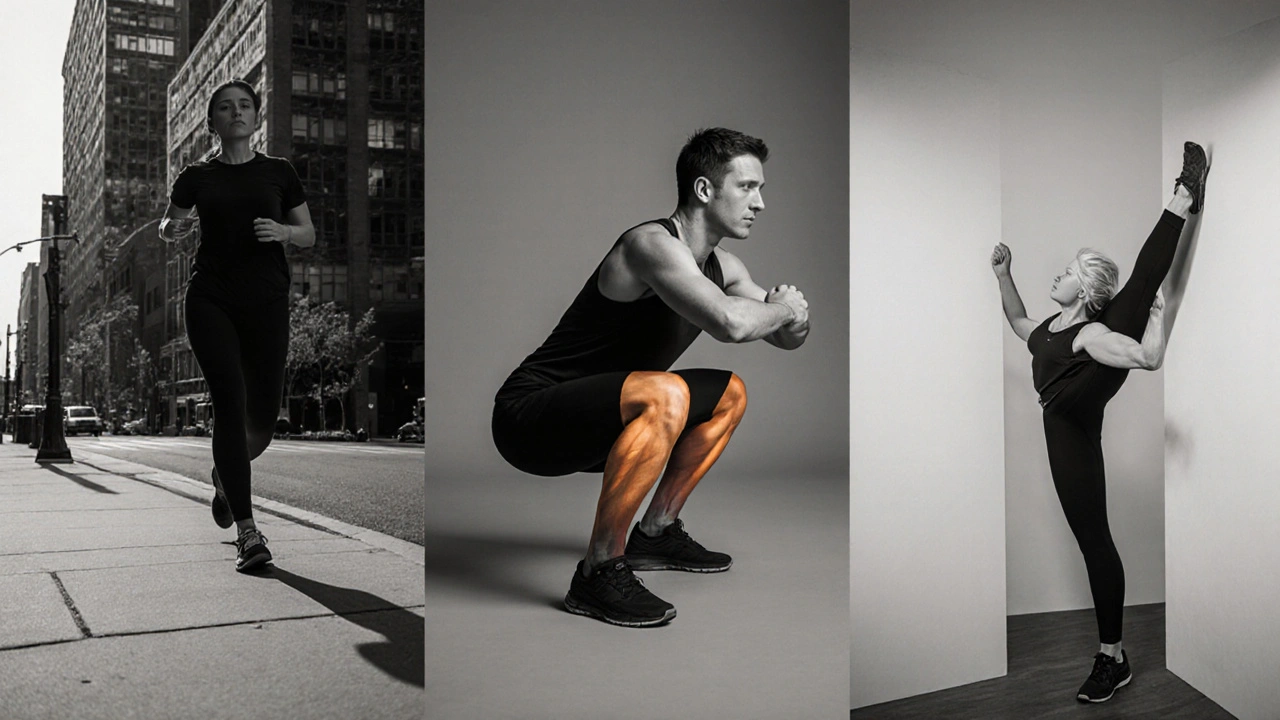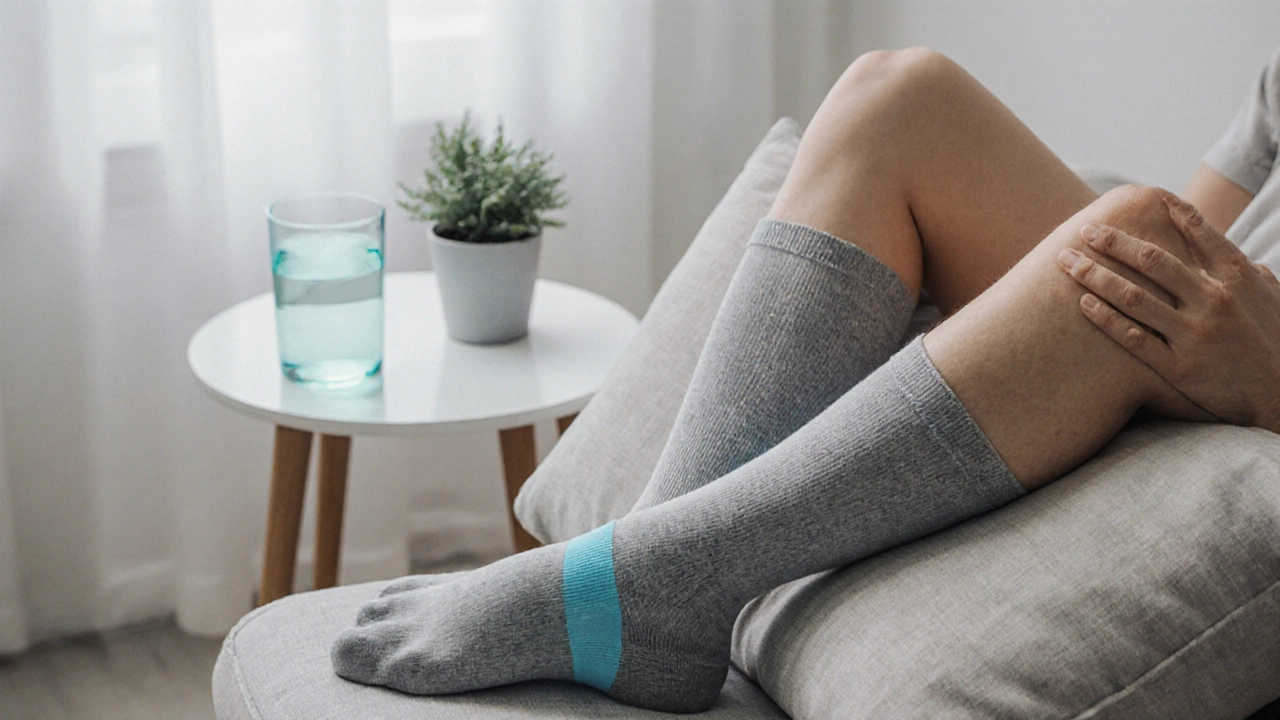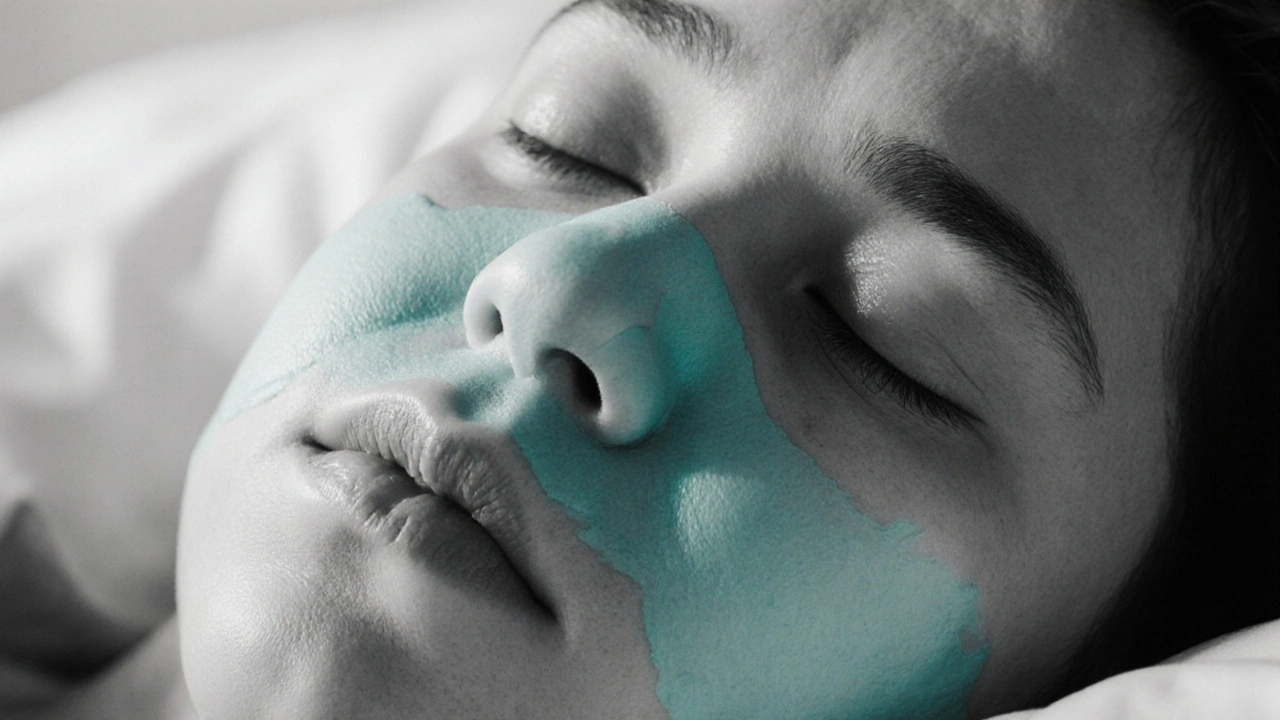Fluid Retention Reduction Checklist
Ever wake up with a puffy face or swollen ankles and wonder why your body’s holding onto extra water? That’s fluid retention trying to tell you something’s off. The good news? You don’t need fancy meds or a strict diet to zap the bloat - a well‑chosen workout routine can do the heavy lifting. Below you’ll find a practical, step‑by‑step guide that explains how fluid builds up, why moving your body matters, and which exercises actually move the excess fluid out of your tissues.
What Is Fluid Retention?
Fluid Retention is the accumulation of excess water in the body’s tissues, often showing up as swelling in the legs, abdomen, or hands. It occurs when the balance between fluid intake, kidney function, and the lymphatic system goes awry. Common culprits include high sodium diets, hormonal shifts, certain medications, and a sedentary lifestyle. When your cells retain too much water, they swell, and the extracellular space expands - that’s the puffiness you see.
Why Exercise Helps Move the Water
Exercise isn’t just about burning calories; it’s a powerful pump for your circulatory and lymphatic systems. Cardiovascular Exercise activities like brisk walking, running, cycling, or swimming that raise your heart rate and improve blood flow. By increasing heart rate, you boost venous return - the flow of blood back to the heart - which in turn drags excess fluid out of the interstitium and back into the bloodstream where kidneys can filter it out.
The lymphatic system, a network of vessels that transport lymph fluid, relies on muscle contractions to move fluid toward the thoracic duct. Every time you contract a muscle, you give the lymphatic vessels a little push. That’s why strength moves, yoga poses, and even simple stretching can speed up fluid clearance.
Top Exercise Types for Reducing Swelling
- Cardio Sessions like 30‑minute walks, jogs, or bike rides at a moderate pace. These elevate heart rate, encouraging more blood and lymph flow.
- Strength Training focused on large muscle groups (squats, lunges, deadlifts) performed in 2‑3 sets of 12‑15 reps. Muscle contractions act like a squeeze‑pump for the lymphatic vessels.
- Yoga & Stretching poses such as Downward Dog, Legs‑Up‑The‑Wall, and gentle twists that promote venous return and lymph drainage. The inversion and gentle compression help fluids flow back toward the heart.
- Low‑Impact Aerobics activities like water aerobics or elliptical training that keep joints happy while still moving blood.

Sample Weekly Routine (30‑45min per day)
- Monday - Cardio: 30‑minute brisk walk (5‑6km/h). End with 5 minutes of ankle pumps (alternating flex/extend feet).
- Tuesday - Strength: Full‑body circuit - 3 rounds of 12 squats, 12 lunges per leg, 12 push‑ups, 12 bent‑over rows (using dumbbells). Finish with a 2‑minute calf raise hold.
- Wednesday - Yoga: 20‑minute flow focusing on forward folds, legs‑up‑the‑wall, and gentle spinal twists. Hold each pose 45‑60 seconds.
- Thursday - Low‑Impact Aerobics: 35‑minute elliptical session at moderate resistance. Add 5 minutes of side‑to‑side stepping to stimulate leg muscles.
- Friday - Combined: 15‑minute jog followed by 15‑minute body‑weight circuit (burpees, mountain climbers, planks). Finish with 5 minutes of deep breathing.
- Saturday - Active Recovery: Light bike ride or leisurely swim for 30 minutes. Emphasize relaxed breathing.
- Sunday - Rest & Mobility: Gentle stretching, foam rolling, and a 10‑minute meditation to lower cortisol (a hormone that can worsen retention).
Boost Your Results with Lifestyle Tweaks
Exercise kick‑starts fluid movement, but a few extra habits tighten the loop.
- Hydration drinking enough water (about 2‑3liters per day for most adults) keeps blood plasma volume stable, preventing the body from hoarding water. Aim for a glass every hour; add a pinch of sea salt if you sweat heavily.
- Sodium Intake excess salt draws water into the bloodstream, increasing pressure that forces fluid out of capillaries into tissues. Keep processed foods under 1,500mg per day and season meals with herbs instead of table salt.
- Compression Garments like thigh‑high socks or calf sleeves that apply gentle pressure, guiding fluid back toward the heart. Wear them during long flights or sedentary office hours.
- Elevate Your Legs lifting legs above heart level for 10‑15 minutes after workouts encourages venous drainage. A simple couch‑prop setup works fine.
Common Pitfalls and How to Dodge Them
Even the best plan can flop if you slip into these traps.
- Over‑training: Pushing too hard can raise cortisol, which actually retains water. Keep intensity moderate and listen to fatigue signals.
- Skipping Warm‑ups: Jumping straight into high‑intensity cardio can cause blood to pool in the lower limbs. Warm up with 5 minutes of marching or gentle arm circles.
- Neglecting Sodium Balance: Low‑salt diets sound good, but too little sodium can cause the kidneys to retain water. Aim for balance, not zero.
- Prolonged Sitting: Desk jobs are a retention nightmare. Stand up, stretch, and do calf raises every hour.

Quick Checklist - Keep It Simple
- Walk or jog 30min at least three times a week.
- Add two strength sessions targeting large muscles.
- Practice a 10‑minute leg‑up‑the‑wall pose daily.
- Drink 2‑3L of water; limit processed‑food salt.
- Wear compression socks on long travel days.
- Elevate legs for 10min after workouts.
- Take micro‑breaks: stand, stretch, calf‑pump every hour.
Frequently Asked Questions
Can exercise completely cure fluid retention?
Exercise is a strong tool, but underlying medical issues (like kidney disease or heart failure) need professional treatment. For most healthy adults, a regular activity routine combined with diet tweaks can dramatically reduce mild to moderate swelling.
How soon will I see a difference?
Most people notice less puffiness within a week of consistent cardio and leg‑elevation. Full results may take 2‑4 weeks, especially if high‑salt habits were a factor.
Is yoga really effective for swelling?
Yes. Inversions and gentle twists compress the abdominal cavity and promote lymphatic drainage, helping fluids move upward toward the heart.
Should I wear compression socks everyday?
If you sit or stand for long periods, wearing them 6‑8hours a day can help. Choose a moderate compression level (15‑20mmHg) to avoid restricting circulation.
What if I’m already on medication that causes retention?
Talk to your doctor first. Often a dosage tweak or adding a diuretic can be paired with exercise safely. Never stop prescribed meds without professional guidance.
Take the First Step Today
Grab a pair of comfy shoes, set a 30‑minute timer, and start moving. The combination of a sensible workout plan, smart hydration, and a little leg‑elevating habit will have that stubborn puffiness fading faster than you think. Remember, consistency beats intensity - a daily habit is the secret sauce for lasting fluid balance.


Chris Beck
October 17, 2025 AT 01:30Stop overthinking just walk
Emily Rankin
October 19, 2025 AT 08:53Imagine the feeling of stepping out into a crisp morning, the air filling your lungs, and each stride pushing the stagnant water right out of your veins. It's not just a workout; it's a rebirth of your body’s natural rhythm, a poetic dance between muscle and lymph. When you commit to that 30‑minute walk, you are whispering to your cells, "We are moving, we are alive." The gentle rise and fall of your heartbeat becomes a tide, pulling excess fluid away from swollen ankles like a tide pulling back from the shore. Each breath you take fuels the circulation, coaxing your kidneys to filter what’s unnecessary. If you add a few ankle pumps at the end, you’re practically massaging the stubborn pockets of water, urging them to drain. The brilliance of this simple routine is its accessibility-no gym membership, no equipment, just a pair of shoes and a willing heart. Over time, that daily ritual transforms puffiness into firmness, and the mirror reflects a slimmer, more vibrant you. Remember, consistency beats intensity; a modest walk every day outperforms an occasional marathon. Let the rhythm of your steps be the metronome of your health, steady and unyielding. Embrace the swell of confidence that follows each session, and watch how your body thanks you with less bloat and more vitality. This is more than exercise; it’s a declaration of self‑care, a promise to your future self to stay fluid‑balanced. So lace up, step out, and let every stride be a victory over retention. The journey begins now, and the path is yours to walk.
Roberta Makaravage
October 21, 2025 AT 16:16Honestly, the science is clear: movement equals less swelling 😎💧. If you skip the cardio, you’re just feeding the bloat, not fighting it. Trust the data, not the hype.
Lauren Sproule
October 23, 2025 AT 23:39i get where ur coming from but lets keep it chill and friendly. the tips are solid and i think the leg‑up‑the‑wall pose is super helpful. also, be gentle on urself, ok?
CHIRAG AGARWAL
October 26, 2025 AT 06:02Dude, you think a few ankle lifts fix everything? Nah bro, you need real sweat, not just lazy leg lifts. Get serious or quit complaining.
genevieve gaudet
October 28, 2025 AT 13:26While we discuss practical steps, it's also crucial to acknowledge cultural variations in diet that affect sodium intake. In many Asian cuisines, fermented foods play a role, and moderation is key. Understanding these nuances helps us apply the routine worldwide.
Nickolas Mark Ewald
October 30, 2025 AT 20:49Great plan, really easy to follow.
Sara Werb
November 2, 2025 AT 04:12Listen up, folks!! This is the ONLY way to beat the bloat, and it's all about patriotism to our health-march, jog, lift, repeat!!! No excuses, no shortcuts, just pure willpower!!!
Winston Bar
November 4, 2025 AT 11:35Well, maybe walking won't fix everything. I've seen people still puffy despite the hype.
Russell Abelido
November 6, 2025 AT 18:58That's a fair point, but consider that consistent movement still offers benefits beyond just fluid reduction :) It improves mood, circulation, and overall vitality. Keep at it, and you might notice gradual improvements.
Steve Holmes
November 9, 2025 AT 02:21Could you clarify how often the ankle pumps should be done? Also, is there a recommended duration for the yoga poses?
Tom Green
November 11, 2025 AT 09:44Great question! Typically, ankle pumps can be performed for about 1‑2 minutes at the end of each cardio session, while yoga poses like Legs‑Up‑The‑Wall are most effective when held for 45‑60 seconds. Feel free to adapt the timing to your comfort level.
Rebecca Mitchell
November 13, 2025 AT 17:07Thanks for the info
Miriam Rahel
November 16, 2025 AT 00:30While the suggestions presented are generally sound, a more rigorous examination of peer‑reviewed literature reveals that the efficacy of low‑impact aerobics on lymphatic drainage is modest at best. Moreover, the recommendation to ingest 2‑3 liters of water daily fails to consider individual renal function variability. For optimal outcomes, a personalized assessment by a qualified physiotherapist or nephrologist is advisable.